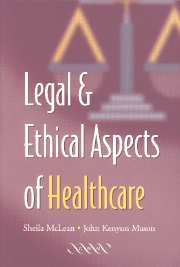Book contents
- Frontmatter
- Contents
- Acknowledgements
- Dedication
- Preface
- A Note on Abbreviations
- 1 About Medicine and the Law
- 2 Resources – Who Decides?
- 3 The Confidential Relationship
- 4 The Therapeutic Partnership
- 5 Refusal of Consent
- 6 Medical Negligence
- 7 Using People for Research
- 8 Assisted Reproduction
- 9 Genetics and Pregnancy
- 10 Termination of Pregnancy
- 11 Genetics, Insurance and Employment
- 12 Is Life Worth Living?
- 13 Disposal of the Body and Body Parts
- 14 Sex, Gender and the Law
- 15 Mental Health and Mental Capacity
- 16 The Law and the Elderly
- Index
2 - Resources – Who Decides?
Published online by Cambridge University Press: 24 August 2009
- Frontmatter
- Contents
- Acknowledgements
- Dedication
- Preface
- A Note on Abbreviations
- 1 About Medicine and the Law
- 2 Resources – Who Decides?
- 3 The Confidential Relationship
- 4 The Therapeutic Partnership
- 5 Refusal of Consent
- 6 Medical Negligence
- 7 Using People for Research
- 8 Assisted Reproduction
- 9 Genetics and Pregnancy
- 10 Termination of Pregnancy
- 11 Genetics, Insurance and Employment
- 12 Is Life Worth Living?
- 13 Disposal of the Body and Body Parts
- 14 Sex, Gender and the Law
- 15 Mental Health and Mental Capacity
- 16 The Law and the Elderly
- Index
Summary
It is very easy to say that the National Health Service should offer all treatments to all persons on a demand basis. Rationing, it might be argued, has no place in a healthcare system the aim of which is to provide universal healthcare free at the point of delivery. The question, however, is whether or not this is possible in the medical environment of the twenty-first century?
Consider the doctor who goes out to do an urgent home visit while patients are still in his or her surgery. He or she is responding to a need but, meantime, others are being deprived of a service they expected to receive. This is rationing, but it begins with a conscious decision to choose to do what is considered best in the given circumstances. It would be nice if the doctor did not have to make such a choice, but practical realities mean that this, or equivalent, choices will be made on a daily basis throughout the healthcare system. By the same token, if a general practice spends one thousand pounds on a particular patient's treatment, that thousand pounds has gone; it cannot be recycled or allocated to other patients, irrespective of need. Effectively, decisions as to the allocation of resources which are all of the same general nature – although not of the same significance – are being made routinely at every level of the service from the general practitioner's surgery to the desk of the Minister of Health.
- Type
- Chapter
- Information
- Legal and Ethical Aspects of Healthcare , pp. 15 - 28Publisher: Cambridge University PressPrint publication year: 2003



